
Wild West
Born in Canada, Pearl Hart was a female bandit who is known as one of the last people to ever conduct a stage coach robbery. She then escaped from prison, and lived a life on the run, which made her an instant celebrity. Hart came from a wealthy family and was well-educated, which made her choice of a life of crime puzzling. She was eventually arrested again, was eventually pardoned, and then disappeared, never to be heard of again.

Pearl Hart
Known by her nickname, ‘Madame Moustache,’ for obvious reasons, Eleanor Dumont, who was born Simone Jules, was a notorious gambler. Dumont was one of the best blackjack players in the Wild West, and she settled in Nevada City. She mysteriously opened a high-class gambling establishment, yet no one knew where a woman of 20 years old got the money to open it. She was known to deal the cards herself, and smoking, swearing, and drinking whiskey were banned at her business…she served champagne, instead.
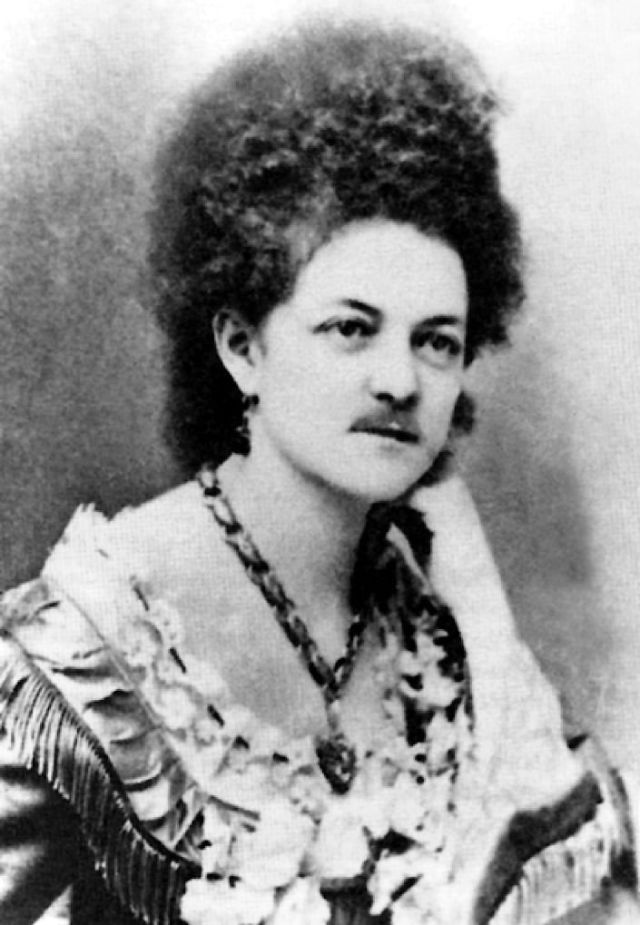
Eleanor Dumont, AKA Madame Moustache
Another thing that the Wild West was known for is all of the people traveling to the West. In 1803, the Louisiana Purchase was made, and people in the country were able to move into the western territory. The United States purchased 828,000 square miles for $15 million from France, and much of this land would be settled by the time the Wild West era was done. Families like these were some of the first to make the dangerous trip from the East.
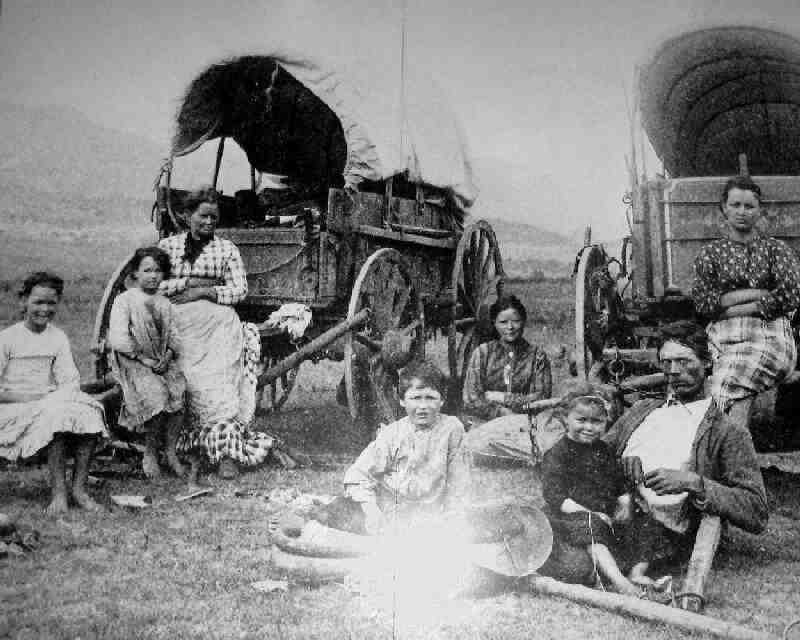
Family Heading West
You have surely heard of “Wild Bill” Hickcok, as he is still a well known folk hero from the Wild West era. He was well known as a frontiersman, and he became famous due to his many alleged adventures…which, over time, were found to be tall tales. While playing a round of poker in 1876, he was shot and killed after insulting a man named Jack McCall. The next day, McCall came into a saloon in Deadwood and shot Hickcok in the back of the head as retribution.
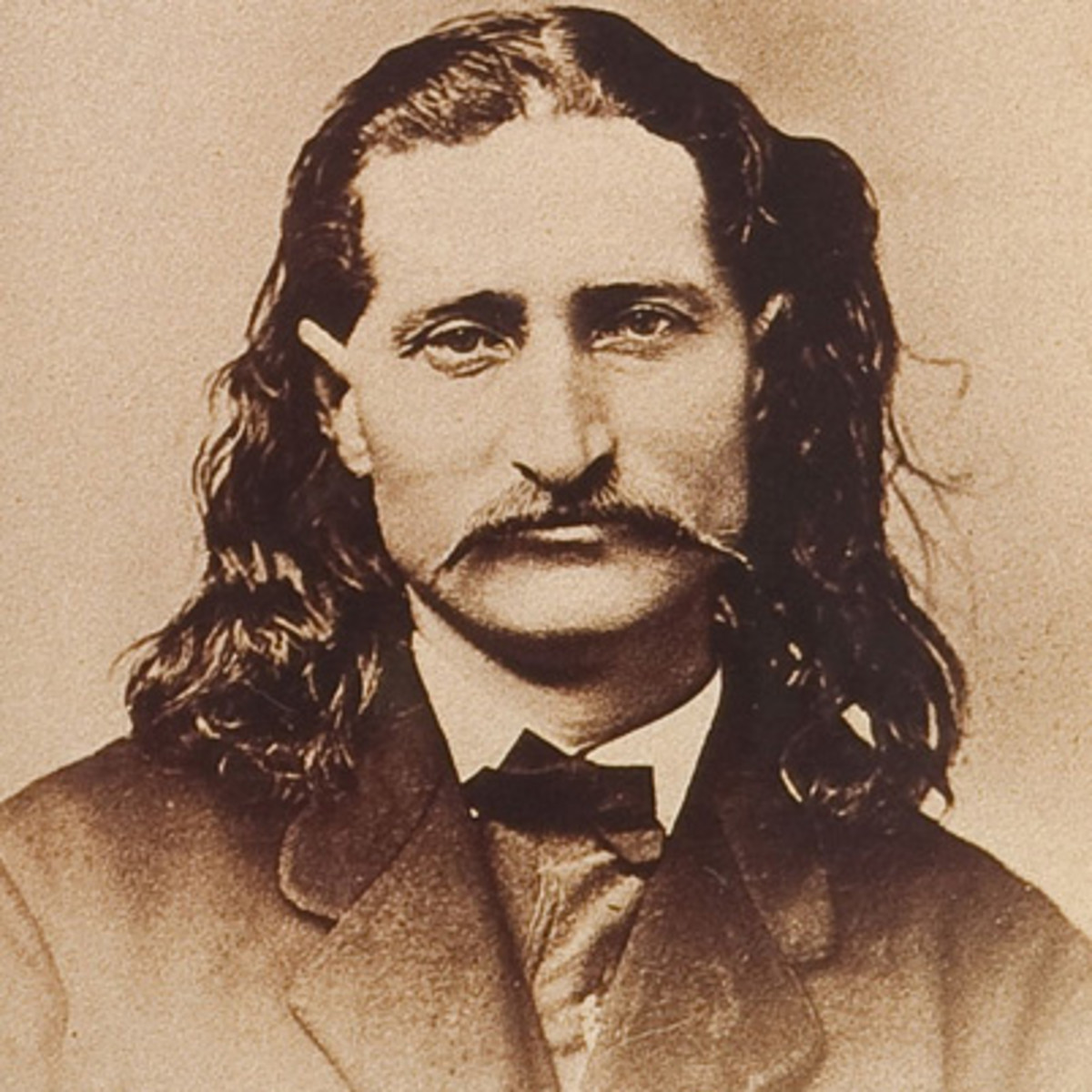
Wild Bill Hickok
This is Charlie Miller, or “Bronco Charlie,” as he was known. He was known for his work with the Pony Express, and he had a couple of reasons for his fame. First, he was the youngest member of the Pony Express, when he joined the organization at the age of 11. He was also known as the last member of the Pony Express, which technically didn’t even last for two years. He then joined “Buffalo Bill” Cody in his Wild West Show.

Bronco Charlie Miller
You have certainly heard of Wyatt Earp, and here’s what he looked like in the flesh. Earp was part of a fairly well-known family, and he was known for being a lawman and gambler, and he was, of course, part of the famed O.K. Corral gunfight along with his brothers, Virgil and Morgan, and Doc Holiday. Wyatt Earp was married four times, and he lived to the ripe old age of 80. Earp died at home after being sick with a bladder infection.

Wyatt Earp
Morgan Earp was Wyatt’s younger brother and fellow lawmen. He was also part of the famed Gunfight at the O.K. Corral, but unlike his brother, Morgan’s life was cut short soon after. Two months following the gunfight, there was an assignation attempt in retaliation on Morgan, which permanently disabled his arm. Three months after that, he was assassinated while playing billiards while his brother, Wyatt, watched. Morgan was only 30 years old.

Morgan Earp
Though we said Wyatt Earp had four wives, his brother, Morgan, only had one; Louisa. She was known around Tombstone as “Lou,” and she was known for her great beauty and cunning intelligence. She and Morgan lived together in Tombstone until he started to get threatened following the Gunfight at the O.K. Corral. He sent his beautiful wife to live with his parents until things settled down. She went, and while there, Morgan was assassinated.

Louisa Earp
People from the East scrambled to the Wild West in search of treasure and a better life. So, it should be no surprise that fortune tellers were popular in the towns that dotted the prairies and mountains. Superstition was commonplace in the Wild West, and it was not unusual to see a fortune teller ready to read tarot cards or a salesman with a wagon full of potions and tonics promising to do everything from make one taller to making you lucky enough to strike it rich with gold.
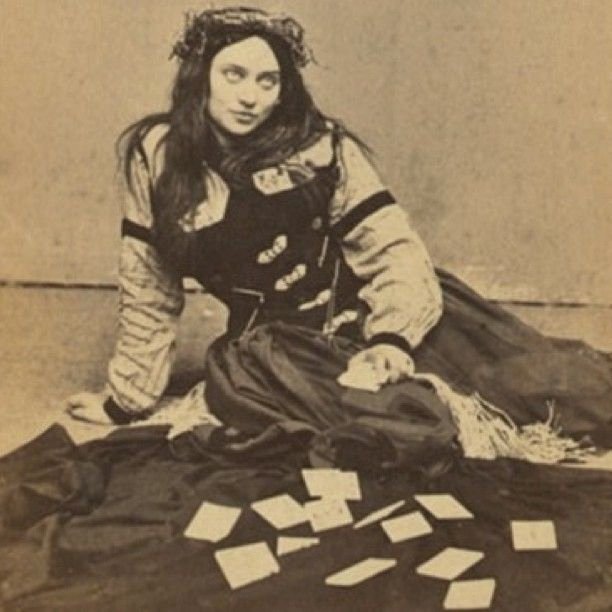
Fortune Teller In The Wild West

Olive Oatman
Born Myra Maybelle Shirley, but best known as Belle Starr, this female outlaw lived an exciting life in the Wild West, and she was mysteriously murdered at the age of 40, which is still unsolved. You might have heard of Belle Starr if you are a fan of Westerns, as she has been immortalized in print and on the silver screen, and she is still known as the “Bandit Queen” and the “Female Jesse James.”

Belle Starr
Ned Christie was a Cherokee outlaw, who met his demise at the end of a lawman’s gun barrel. He became famous due to a standoff with lawmen after he barricaded himself in his home after he was accused of murder. This standoff lasted for five years, and during that time, Christie was even able to build a new, stronger home, with the help of his family and friends. Ultimately, the “war” ended when Christie was ultimately shot by Wess Bowman, a deputy.
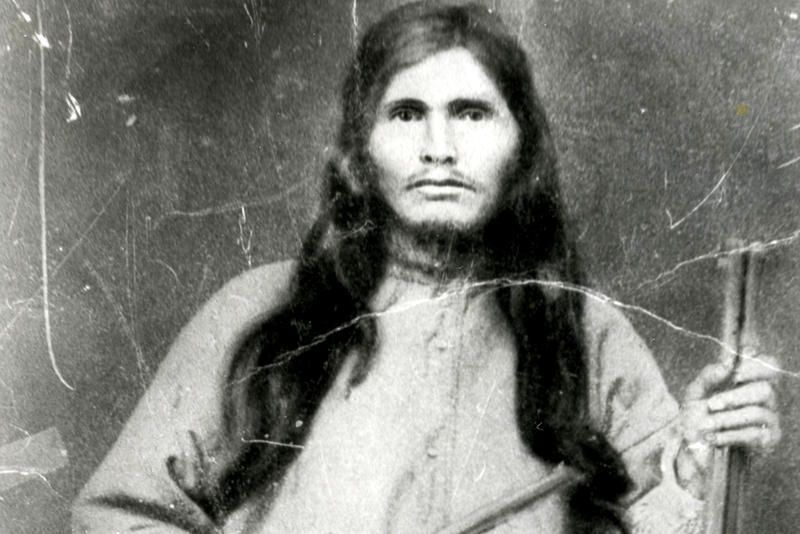
Ned Christie
The “Rose of the Wild Bunch,” Laura Bullion was close with other outlaws like Butch Cassidy, and learned a life of lawlessness from her father, who was a bank robber. Known for her rough exterior and romantic involvement with many members of the “Wild Bunch,” Laura eventually gave up a life of crime after a stint in prison for robbery. She lived a long life, eventually dying in 1961 at the age of 85 due to heart disease.

Laura Bullion
Of all of the gangs in the Wild West, the Rufus Black gang might have been the most brutal. Though the gang wasn’t around too long, these men quickly gained a reputation of murderers, rapists, and robbers. These men were so cruel and vicious that two women died after being raped and tortured by the gang. The gang was captured by a mixed group of US lawmen and Creek Indian police. They were all hanged together after being sentenced to death in 1896.
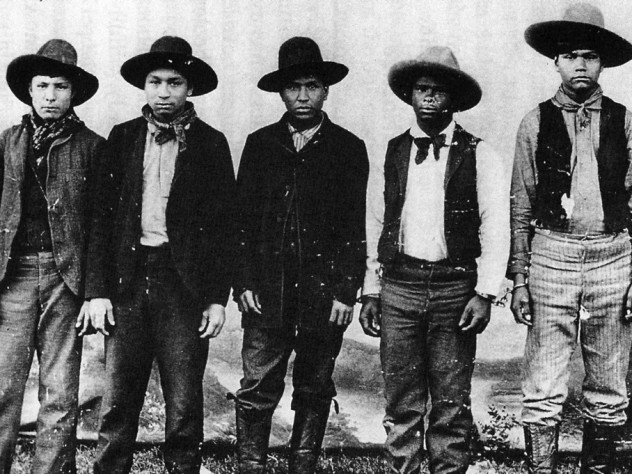
Rufus Buck Gang
If there is any outlaw that you probably know from the Wild West, it is likely Jesse James. He and his brother, Frank, were part of many gangs following the Civil War, and were well known robbers of trains, stage coaches, and banks. Eventually, they started their own gang, which ultimately put them on the outlaw map. During his life, he was a notorious celebrity, and after death, he became a legend of the Wild West.

Jesse James
There are some pretty funny nicknames for people from the Wild West era, but we think the one that takes the cake is Big Nose Kate. She was common law married to the famed lawman, Doc Holliday, and worked as a prostitute, even after she and Holliday got together. Big Nose Kate was also known to help Doc out of precarious situations, including allegedly setting fire to a hotel to get Doc out of some trouble.

Big Nose Kate
You have surely heard of Custer’s Last Stand, right? He was a General in the US Army, and died at the age of 36 in the Battle of Little Bighorn, which is also known as “Custer’s Last Stand.” There is a bit of controversy here, though, because it is believed that Custer and his widow really played up his accomplishments and he wasn’t as great as people think.
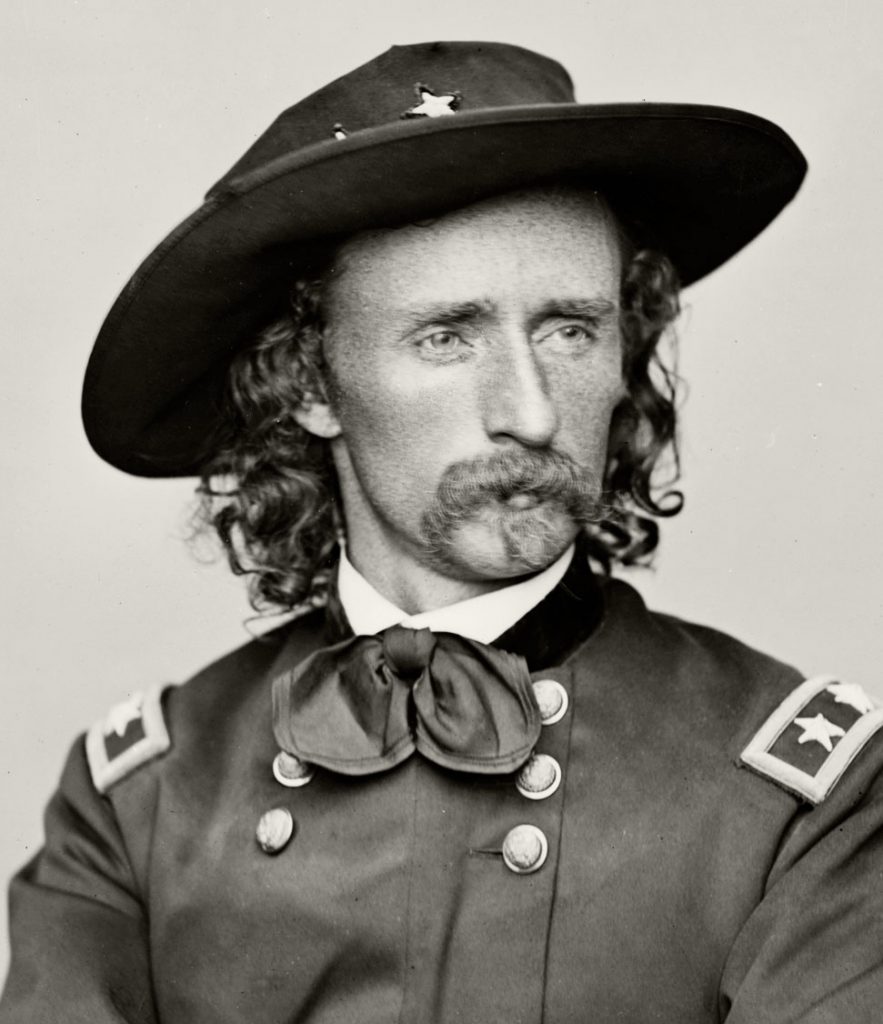
George Armstrong Custer
Though there were many Wild West shows in existence, the most famous, of course, is the one put on by “Buffalo Bill” Cody. This show even went across the pond to Europe, and it featured everything from Wild West gunslinging to buffalo hunts, and any other reenactment of Wild West life that you can imagine. The show lasted from 1870 to 1920.

Buffalo Bill’s Wild West Show
This is Spotted Elk, who would eventually die on the same spot as he lays in this photo. A famed Lakota Sioux chief, Spotted Elk is shown here after being gunned down by a member of the U.S. Army during the Wounded Knee Massacre in 1890. Though Spotted Elk was well into his 60s, he was a strong man. On this day, he was suffering from pneumonia, too, but he wanted to fight for his people. Sadly, he wouldn’t live, and with him, 152 others would die that day.
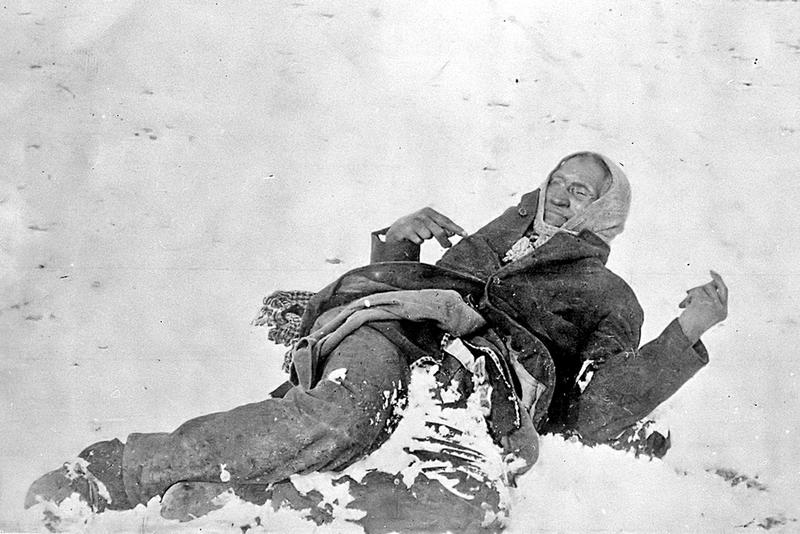
Spotted Elk
Saloons were a popular staple in the Wild West, and this one, found in Table Bluff, California, also served as a hotel. Taken in 1889, you can see four men along with some very interesting furniture pieces. It looks like these chairs were made from fur and antlers, presumably from local hunts, and along the back wall of the saloon you can see several bottles of alcohol, which were likely greatly enjoyed by the patrons.

Table Bluff Saloon
Life out on the prairie and in the desert was hard, and it was also very dirty. The opportunities for bathing were few and far between when on a cattle drive, for instance, so when these cowboys found an opportunity to get clean, they took it. Here, you can see several men bathing in a river with several others waiting for their turn. You can even see the horses taking advantage of the cool water, as life on the prairie could get pretty hot, too.

Cowboys Taking A Bath
If the danger of animals, outlaws, and other dangers weren’t enough to deal with in the Wild West, if you settled down, you also had to contend with dust storms. These storms were common on the plains, and you had to understand that if you were going to live in this area of the country, that you would have to put up with storms like these. You also, of course, had to deal with tornados, and homes back then were certainly not as well-built as our houses, today.

Dust Storm Approaches
Gambling was so common in the era of the Wild West that when towns were settled, one of the first buildings that went up were gambling halls. Some of the most popular games included faro, roulette, craps, and chuck-a-luck. Though you can see men here in this photo, gambling was also popular among women, and it was common to see the ladies around the card table, too.

Gambling In The Wild West
The Sioux Nation, which consisted of the Lakota, Western Dakota, and Eastern Dakota, were one of the largest groups of Native Americans in the Wild West. Imagine being a person coming from the East and seeing hundreds of teepees, which you had never seen before, dotting the landscape like these are.

Sioux Teepees
The Gold Rush brought people from all over the world to the west, and because of the influx of miners, towns began popping up all over the place. The town seen here was Deadwood, which was in Dakota Territory, and turned into a thriving Western city. Most of these towns fell into disrepair and became ghost towns after the Gold Rush, but Deadwood still remains, today.

Deadwood
Thousands of people, including families, left the East and headed West seeking out a better and brighter future. In most cases, these people traveled by covered wagon. These wagons were typically 7-8 feet tall, and could be as long as 10 or 11 feet. They could hold the entire family, as well as their belongings. Families could even sleep in them, if necessary.
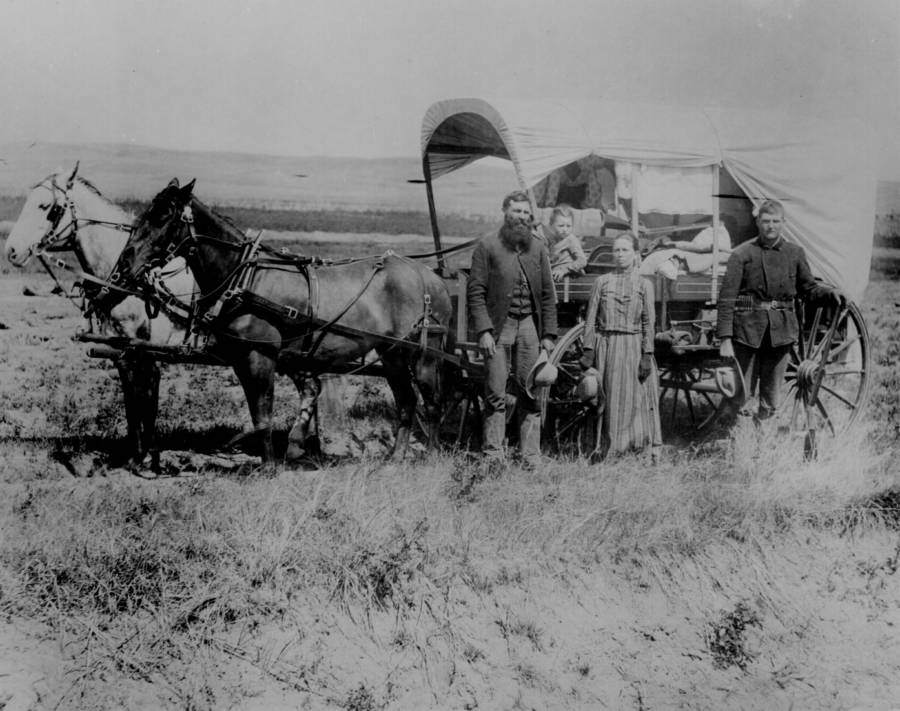
Covered Wagon And A Family
This boy in the front is Jimmy “Santiago” McKinn, and he is surrounded by members of the Apache tribe. Jimmy was abducted by the Apache after the tribesmen killed his brother. Ultimately, the Apaches made Jimmy a part of his own, and they called him “Santiago.” He was ultimately found and rescued, though Jimmy/Santiago tried his best to stay with the Apache, as he saw them as his new family.

Jimmy “Santiago” McKinn
This photo shows miners sitting at a camp. During the Gold Rush, the miners found camp wherever they could. The land was saturated with people with dreams of getting rich, but most of them would end up being sadly disappointed. Thought people DID find wealth, it was generally from setting up businesses to meet the needs of the miners, including restaurants and hotels.

Mining Camp
With so many small towns popping up throughout the West, there were plenty of opportunities to find a place to build a home. The problem is, however, is that there was a lot of competition, and the lots were not cheap. If you had the money and you got there at the right time, you could choose which lot to build on, just like this man is doing in the photo below, which was taken in Guthrie, Oklahoma in 1889.

Looking For A Lot
As towns were being built, you couldn’t find the same comforts that you were used to in the East. In fact, it was quite rough and tumble, especially for people who were used to living in the larger cities during that time. Here, you can see another photo from Guthrie, Oklahoma, which shows you the local blacksmith shop during the town’s building.

The Blacksmith Shop
At the height of the Gold Rush, it was near impossible to find some land to settle on, especially in California. So, when this happened, there was a land auction. To participate, you had to have money, time, and a little bit of luck to get the winning bid. You can see how crowded it was at this auction…standing room, only.

Land Auction
Here, you can see a sod house, which was the first ever built in Dodge City. This home was built in 1871. Why was sod used? Because there were very few, if any, trees around the prairies, so the people heading West had to be creative. They cut large pieces of sod, which contained the strong prairie grasses, allowed the pieces to dry in the sun, and then used the hard, sod bricks to build their homes.

Sod Home
At the end of the 1800s, the railroad was beginning to expand out to the West. But, before a person could take the railroad, it had to be built. There were a lot of railroad jobs available, but it was hard, tough work. Here, you can see a railroad being built in Arizona in 1898.

Building A Railroad
Even when you found land to build a home in the Wild West, it could still be pretty lonely. Here, you see a young girl feeding a flock of chickens, but if you look behind her and around the home, you see nothing but land. Though some people like this type of solitude, it could be lonely, and even a bit dangerous, during the time of the Wild West.
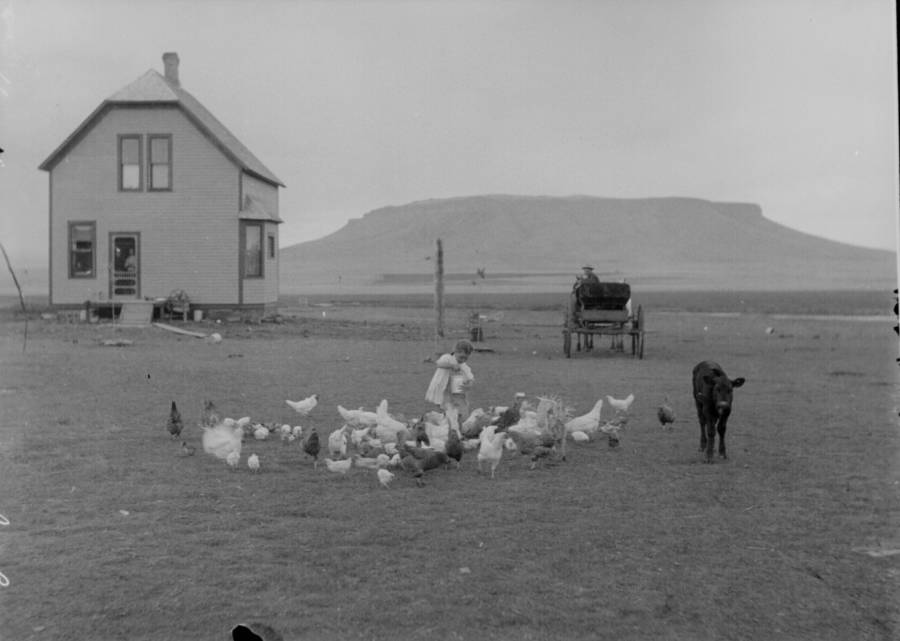
A Western Homestead
We have already talked about the saloon, but these photos are so fascinating, we might as well look at more. These saloons were a very important part of life in the Wild West, and most of them sold whisky, gin, and warm beer, as refrigeration was difficult in the West. Many also offered a free lunch, which would be given if the patron bought a drink.

Nevada Saloon
Once you found a place to live, you had to have nearby shops and stores, and most Wild West towns had a dedicated downtown area where residents could find the goods they needed. This is the downtown area of Corrine, Utah, and this photo was taken in 1869. Here, you can see the hardware store, the painters, and of course, the jewelry store. You had to do something with your gold, right?

Downtown Street
Most children in the East were educated by this time, so when families began to move out West, schools were needed there, too. Teachers were trained in the East and then went West to set up schools of their own. There was also the possibility that a teacher could find a school by answering an ad in an Eastern newspaper, which advertised open positions out in the Western part of the country.

Western Schoolhouse
One of the ways that people made a living in the Wild West was to trap and hunt animals. There was a big demand for fur in the East, as it was considered a luxury item, and in the West, it was often quite cold, so the people wanted the furs to make coats, blankets, and other items. Here, you can see a cabin with some fresh skins, which will soon be made into goods.

Trappers Outside Of Their Cabin
Brothels were very common in the Wild West, too, and with so many men out in the west without female companionship, it is no wonder that many of the women who came out from the east found themselves working in brothels. These two are working in a brothel in Alaska, and as you can see, they are showing off their wares to potential customers.

Women Working In A Brothel
When most people think of a brothel, they think of a dirty, dingy place where men would go for a quick tryst. However, as you can see in the photo below, there were certainly classier options. These women certainly don’t look like those who you might think worked in a brothel. In fact, they look very much like women who might be a teacher, a shopkeeper, or even a friendly neighbor.

Women In A Brothel In The Wild West
This is Bessie Colvin. She was working at one of the brothels in El Paso, TX during the Wild West era. Scandal hit the town when Bessie left the brothel she was working in for a brand new one. It was such a big deal that the madame of her old brothel and the madame at her new brothel ended up fighting in the street! It only ended when one shot the other in the thigh.

Bessie Colvin
Brothels were actually a big part of the economy in Wild West towns, including Dawson City, up in Canada, which is where this photo was taken. This was a type of promotional photo of some “good time girls,” who were hoping to find some customers. We are sure they were able to find some, as there were almost no other women up there at this time.
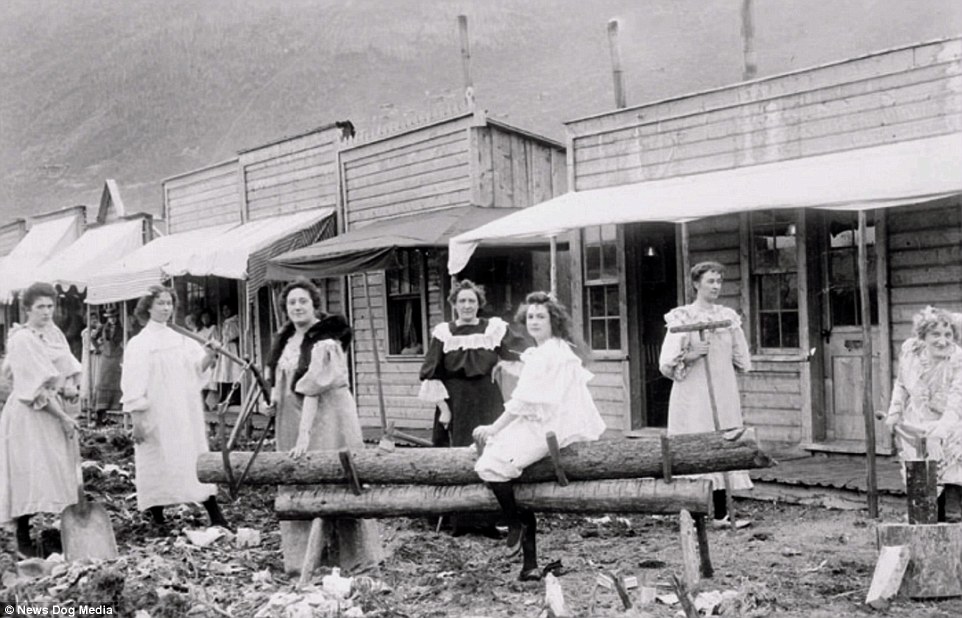
Good Time Girls
This is Mattie Silks. She started off as a “good time girl,” but then got into the business herself as a madame. She had two highly successful brothels, one in Denver and one in Dodge City. Mattie had a reputation for running a high class establishment, and she was so good at what she did, that she made about $38,000, which is the equivalent of a million dollars, today.

Mattie Silks
Belle Brezing was a nationally-known madame who started a brothel in the former home of Mary Todd Lincoln, the First Lady. What made Belle so different from the other madames out there is because she only catered to a certain clientele; she would only allow high class gentlemen to enter her brothel, and even during the Spanish-American War, she would only also senior military officers in.

Belle Brezing
Here’s another prostitute from the Wild West, Julia Bulette. When she was 27-years old, she moved to Virginia City, Nevada, and was the only single woman in the city. So, she began to prostitute. She was much-loved in the city thanks to her charity and her devotion to the town. When she was murdered in 1867 by a drifter, the entire town went into mourning and thousands came to her funeral.

Julia Bulette
Though some areas of the Wild West were chilly or even cold, other areas, like Death Valley, were extremely hot. In fact, it could get as hot as 130 degrees, and more, though that was rare. Here, you can see a couple of wagons and a lot of horses. They were looking for borax, which was a mineral they could sell for cold, hard cash.

Death Valley
This is a photo of John Wilson Vermillion, who was known as “Texas Jack.” He was a legendary gunslinger, and he often worked with Wyatt and Morgan Earp. He was very anti-outlaw, and spent much of his life searching of them. Many people also called him “Shoot Your Eye Out Vermillion” because of the time he literally shot a man in the eye.

Shoot Your Eye Out
One of the most famous names to come out of the Wild West was Annie Oakley. She was a highly gifted female sharpshooter, and she became a household name thanks to her skills. Annie met Frank E. Butler as a teenager, and the couple travelled with Buffalo Bill’s Wild West Show showing off their skills.

Annie Oakley
This is Curly. He was a scout for General Custer in the Battle of Little Bighorn. At the time, Curly was only 17-years old, and for a time, it was thought that he was the only survivor of the battle. This is because he could not speak English, and when he reported what had happened in the battle, he only used rudimentary sign language. Curly became famous thanks to this, and many people wanted his photograph.

Curly
There were a lot of infamous outlaws in the Wild West, but none of them were as ruthless or deadly as Bloody Bill. He was a leader of a gang known as Quantrill’s Raiders, and during the Civil War, he killed at least 120 Union soldiers…and he wasn’t part of the fighting. The Union had their revenge, though, as Bloody Bill was gunned down by Union soldiers in 1864.

Bloody Bill
Building the railroad was a top priority of the US government during the Wild West era, and as we have mentioned, it was hard, difficult work. Most of the workers got paid $2.50 a day, but not all of them. Chinese workers, who were treated much like servants, were only paid $1.00 a day. Approximately 15,000 Chinese men worked on the railroads, and they were considered cheap, inferior laborers.

Chinese Laborers
Calamity Jane was a professional scout and frontierswoman during the Wild West era. She was a heavy alcoholic, and a close, personal friend of Buffalo Bill. In fact, she even performed in his show later in her life. Jane often dressed in men’s clothing, and when Buffalo Bill was murdered, she went after her murderer with a cleaver because she said she had forgotten her guns at home. She was also known for her tall tales, so it’s unknown if this is a true story…or not.

Calamity Jane
Buffalo Bill Cody was one of the most famous people to ever come out of the Wild West, and he was known worldwide for his show. Before getting into showbiz, though, he was a soldier and a bison hunter. Bill even received the prestigious Medal of Honor in 1972. He had great wealth, but lost much of it before he died. Though, you can’t feel too bad for him, as he was still worth almost $2 million in today’s money.
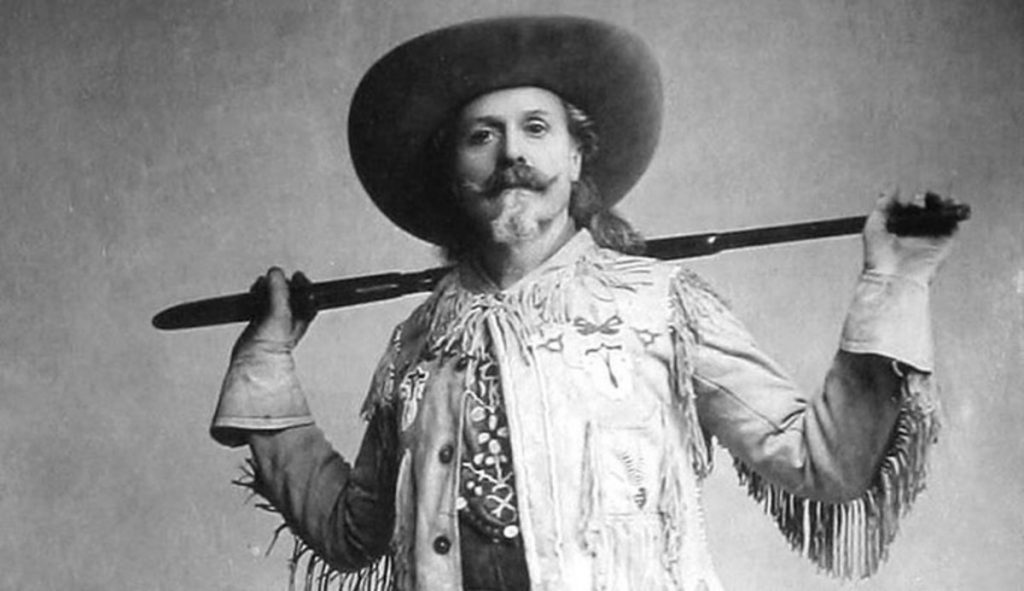
Buffalo Bill Cody
You have probably heard of the Donner party because of the stories of cannibalism. Basically, the story goes that the Donner party, made of members of the Reed family, Donner family, and others took off on the Oregon Trail. Eventually, the party got stuck in a terrible snow storm, and got stuck. Of the 87 people who left, only 48 survived.

James And Margret Reed
One of the most famous Native Americans during the Wild West era was Chief Joseph, who was the chief of the Nez Perce tribe. The Nez Perce were removed from their lands in Oregon and forced into a small reservation in Idaho Territory. He led his people during this time and during the retreat fought with U.S. Marshalls in a fight known as the Nez Perce War.

Chief Joseph
This is General George Crook, who became known as the “Indian Fighter.” Though he played a part in removing the Native people from their lands, General Crook had a reputation of trying to solve these issues with diplomacy instead of through force. In his later life, Crook became a champion for Native Americans and the treatment they had endured over the years.

George Crook
This is a photo of Billy Simms, a famed gambler from San Antonio TX. Like other gamblers of the Wild West, Simms was part of a wild and raucous bunch of people, and he considered himself to be at the pinnacle of society. He made a lot of money, and he dressed in the finest clothes. We aren’t sure whatever happened to Billy, but many gamblers ended up losing their fortunes in a big loss.

Billy Simms
The Texas Rangers were founded in 1823 when new families were coming into Texas during the Mexican War of Independence. Stephen A. Austin, known as the Father of Texas, hired 10 men, seen below. However, their reputation was more of violent men than men who protected families, and they fought everyone from Mexican citizens to Native Americans.

Texas Rangers







